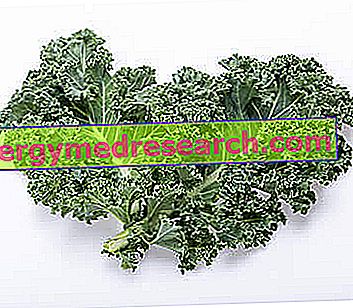What is kale?
Curly kale (in English " curly cale ") is the name of a particular cultivar of cabbage called sabellica ( Brassica oleracea var. Sabellica) .

Also known as leached cabbage and, perhaps improperly, as kinky black cabbage, this variety is obtained only by cultivation and is not available in the wild. Note : in botany, some authors make a distinction between kale and kale. The latter, referred to as Brassica oleracea variety acephala sabellica, could represent a cross between the aforementioned kale ( sabellica ) and the well-known Tuscan black cabbage ( acephala ).
Unlike cauliflower, broccoli and romanesco (flowering cabbage), only the leaves are eaten from the kale, which are green, with a rippled profile and typically separated (NOT per head, like the cabbage and the cap).
As for its cultivation, kale bears well with heavy soils and winter cold, which is why it is particularly rustic and undemanding.
Among the most widespread culinary uses are soups, soups and stews, such as, for example, the Tuscan ribollita.
Regarding the nutritional aspect, the kale is classified in the VI and VII fundamental group of foods because, besides containing excellent amounts of fiber and water, it is also rich in vitamin A (carotenoids) and vitamin C (ascorbic acid).
Nutritional Properties
Nutritional characteristics of curly kale
Kale is a food that contains few calories, even if, in the context of vegetables, it is considered a medium energy product. Calories are provided mainly by carbohydrates, followed by proteins and finally by negligible amounts of lipids.
Carbohydrates are mainly simple (especially fructose), medium-low biological value peptides (they do NOT contain all the essential amino acids in the right proportions) and polyunsaturated fatty acids. Cholesterol is absent and the fibers are abundant.
With regard to mineral salts, kale contains high amounts of potassium and discrete levels of calcium and iron (the latter, which is not very bioavailable). As far as vitamins are concerned, significant levels of ascorbic acid (vitamin C), carotenoids (pro vit. A) and folate are observed.
The kale is also rich in phytosterols and polyphenols, with antioxidant characteristics and beneficial for metabolism, and glucosinolates.
It contains many purines, but the factors most often responsible for food intolerance, such as lactose, gluten and histamine, are totally absent.

Kale is suitable for most diets. It has no contraindications in case of overweight and metabolic pathologies; on the contrary, it is considered a therapeutic food. Thanks to the abundance of potassium, it lends itself to the diet against primary arterial hypertension.
Polyunsaturated lipids and phytosterols play an important role in the balance of lipemia, countering hypercholesterolemia, hypertriglyceridemia, improving health status in case of type 2 diabetes mellitus and, more generally, of metabolic syndrome.
The fibers prevent and counteract constipation; they also contribute to modulating intestinal absorption, decreasing the uptake of fats and cholesterol, and regulating the glycemic-insulin surge.
The abundance of carotenoids, vitamin C and polyphenols hinders general oxidative stress, to the benefit of the metabolic condition, reducing cellular aging and, also thanks to the action of glucosinolates, the predisposition to certain tumors.
The abundance of folates suggests consumption during pregnancy; however, due to cooking, folate and vitamin C are largely degraded. This would suggest consuming it raw; on the other hand, in case of pregnancy it is necessary to minimize the risk of food poisoning and parasitosis. A good compromise to reduce the microbiological risk is the use of food disinfectants such as Amuchina. It must be remembered that the cooking of cabbages also has another function, namely that of inactivating certain undesired compounds that interfere with the metabolism of iodine, compromising the activity of the thyroid; obviously, this "gozzigeno" effect has a significant impact only in people already affected by gland pathologies and who take very little iodine.
Being able to choose, it is advisable to cook the food by steaming or preserving its water (stewing), avoiding boiling (or drowning), which causes the loss (dilution) of many water-soluble nutrients, especially minerals. The richness of purines limits its use in food therapy against hyperuricemia (which is the basis of gouty attacks); on the other hand, if the pathology is appropriately compensated for by drugs, food is not a problem.
The kale has no contraindications for intolerance to milk sugar, for celiac disease, for histamine intolerance and for the most frequent food allergies. It is highly valued in vegetarian, vegan food philosophies and has no religious implications.
The average portion of kale is 100-200 g (about 50-200 kcal).
Description
The kale can grow up to almost a meter in height in the high or wide varieties in the low ones. Its leaves are deep green (not blue, like black cabbage), about two centimeters wide, with a fairly regular surface but typically curled edges.
The taste of curly kale is less sweet and delicate than black cabbage, vaguely bitter and quite earthy.
Recipes and Kitchen
Culinary uses of curly kale
Kale is mainly used as an ingredient for side dishes, raw or cooked: curly cabbage salad, boiled kale (steamed or boiled), stewed or sautéed kale.
However, there is a long series of recipes, especially pasta and hors d'oeuvres, based on kale. Some are: pasta with kale, orzotto with kale, cicerchie soup and kale, Tuscan ribollita, bruschetta with curly kale and lard, curly cabbage pesto and kale (cabbage) and cabbage.
Cultivation
Notes on the cultivation of curly kale
Kale is a variety that grows well even in the shade and can be planted after potatoes. The distance between the plants is usually 40 x 50 centimeters. It is sown from May to June in seedbeds and must be transplanted into soil rich in organic substances from June until August.
For home cultivation it is advisable to prefer low-leaf types (quite rare in Italy).
Kale is resistant to low winter temperatures and, like black cabbage and Brussels sprouts, needs the first winter frosts to acquire maximum flavor. The collection is progressive; it starts with the lower leaves and lastly leaves the "heart" (leaving the stem on the ground, in spring some more tender shoots appear). For the organic cultivation of curly kale we recommend treatments such as: algae limestone (against the cabbage hernia), wood ash or primitive rock flour (for aphids), alternation of tomatoes and celery (to keep the cabbage bushes away) ). Spinach, potatoes, leeks, salads and peas also lend themselves to alternation.
Some aromatics to be planted as a border, such as chamomile, coriander and cumin (avoid mustard) can enhance the aroma of the finished product.



